BACC3002 - Strategic Management Accounting: Balance Scorecard Report
VerifiedAdded on 2023/03/30
|11
|1452
|380
Report
AI Summary
This report provides a comprehensive analysis of a Balance Scorecard implemented by Centrelink Australia, examining its adoption, implementation challenges, and long-term goals. It identifies key stakeholders and outlines suitable perspectives for the scorecard, including financial, customer, learning, and business process perspectives. The report develops a strategy map to illustrate the relationships between different objectives and identifies Key Performance Indicators (KPIs) and Key Performance Drivers (KPDs). The study concludes with a summary of the Balance Scorecard's purpose and value for the organization and its stakeholders.

Running head: BALANCE SCORECARD
BALANCE SCORECARD
Name if Student
Name of the University
Author Note
BALANCE SCORECARD
Name if Student
Name of the University
Author Note
Paraphrase This Document
Need a fresh take? Get an instant paraphrase of this document with our AI Paraphraser
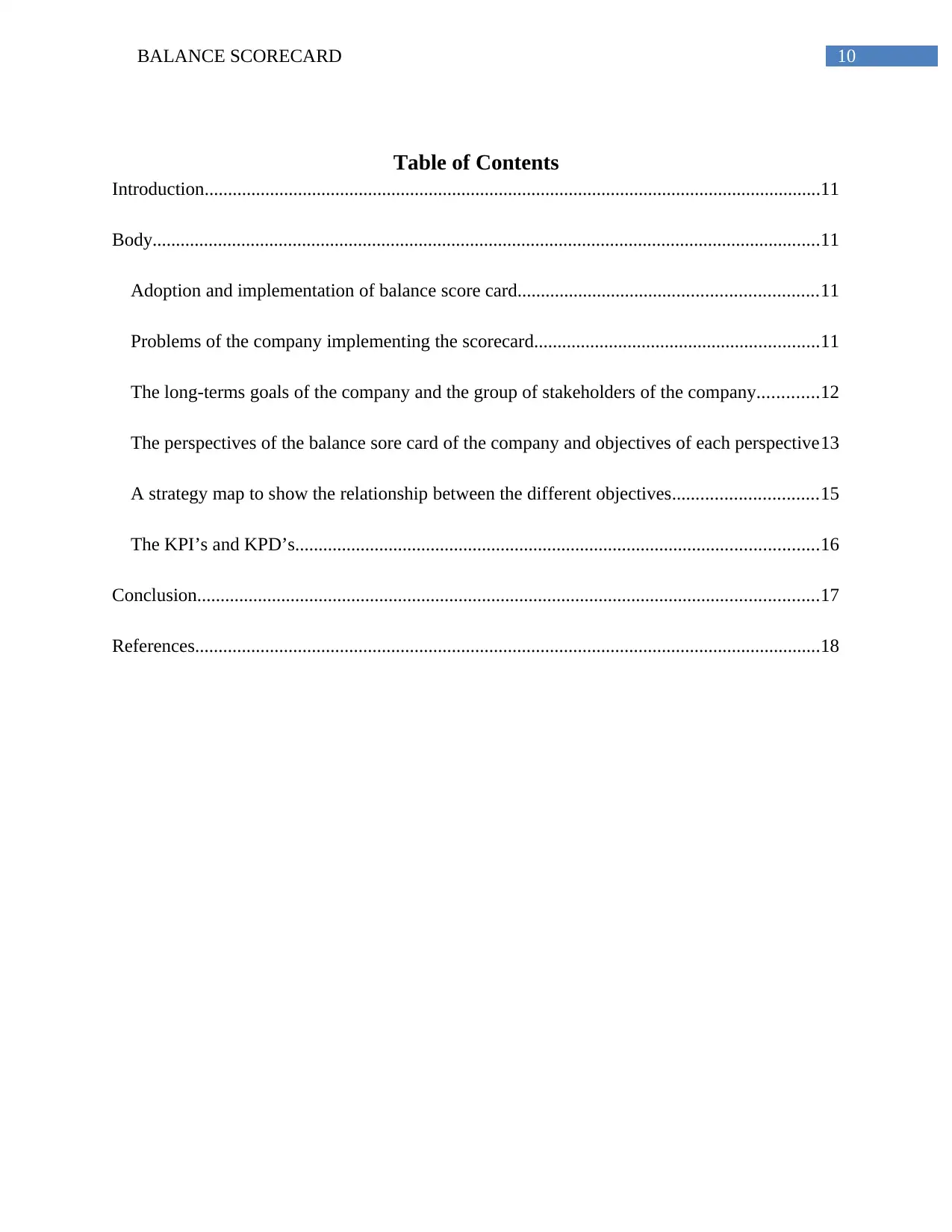
10BALANCE SCORECARD
Table of Contents
Introduction....................................................................................................................................11
Body...............................................................................................................................................11
Adoption and implementation of balance score card................................................................11
Problems of the company implementing the scorecard.............................................................11
The long-terms goals of the company and the group of stakeholders of the company.............12
The perspectives of the balance sore card of the company and objectives of each perspective13
A strategy map to show the relationship between the different objectives...............................15
The KPI’s and KPD’s................................................................................................................16
Conclusion.....................................................................................................................................17
References......................................................................................................................................18
Table of Contents
Introduction....................................................................................................................................11
Body...............................................................................................................................................11
Adoption and implementation of balance score card................................................................11
Problems of the company implementing the scorecard.............................................................11
The long-terms goals of the company and the group of stakeholders of the company.............12
The perspectives of the balance sore card of the company and objectives of each perspective13
A strategy map to show the relationship between the different objectives...............................15
The KPI’s and KPD’s................................................................................................................16
Conclusion.....................................................................................................................................17
References......................................................................................................................................18
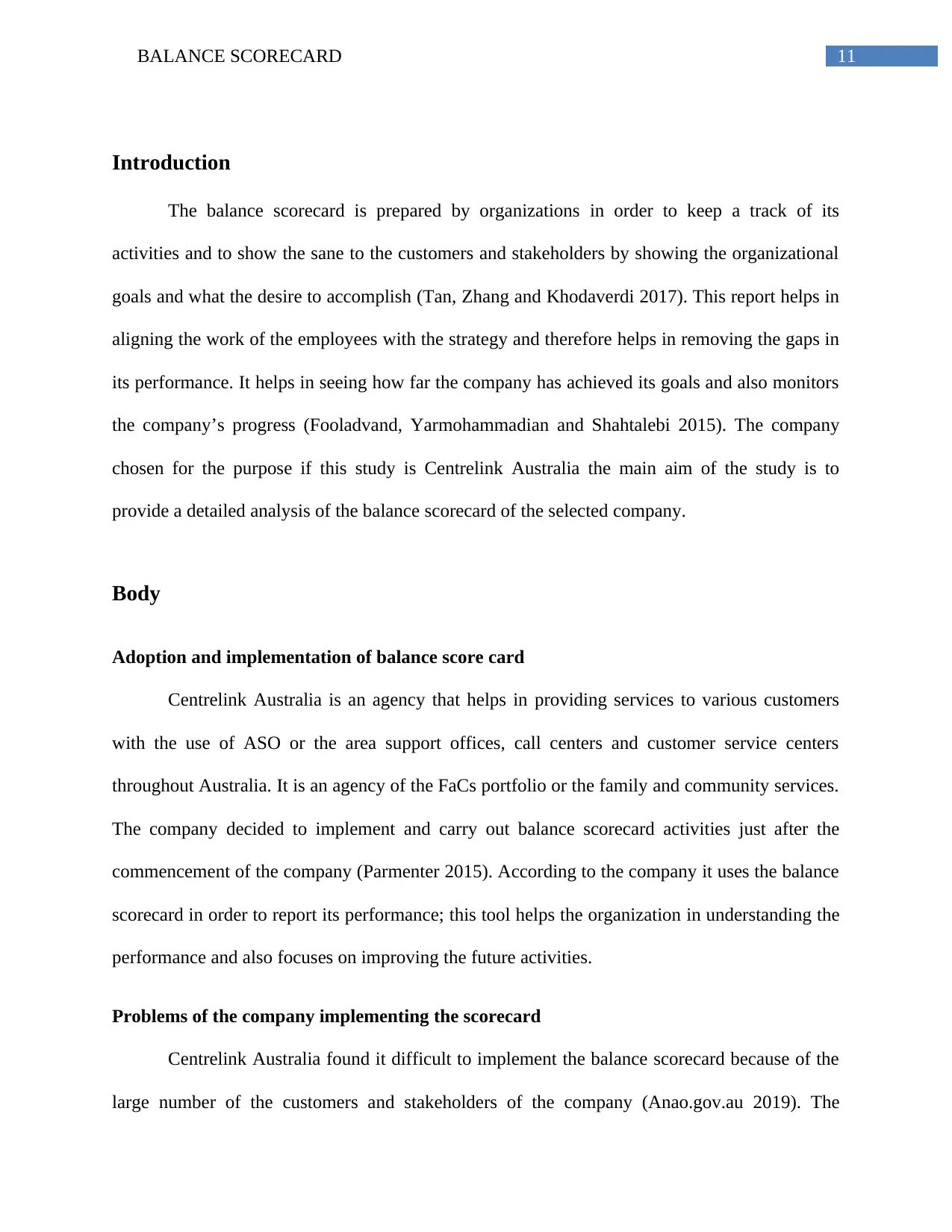
11BALANCE SCORECARD
Introduction
The balance scorecard is prepared by organizations in order to keep a track of its
activities and to show the sane to the customers and stakeholders by showing the organizational
goals and what the desire to accomplish (Tan, Zhang and Khodaverdi 2017). This report helps in
aligning the work of the employees with the strategy and therefore helps in removing the gaps in
its performance. It helps in seeing how far the company has achieved its goals and also monitors
the company’s progress (Fooladvand, Yarmohammadian and Shahtalebi 2015). The company
chosen for the purpose if this study is Centrelink Australia the main aim of the study is to
provide a detailed analysis of the balance scorecard of the selected company.
Body
Adoption and implementation of balance score card
Centrelink Australia is an agency that helps in providing services to various customers
with the use of ASO or the area support offices, call centers and customer service centers
throughout Australia. It is an agency of the FaCs portfolio or the family and community services.
The company decided to implement and carry out balance scorecard activities just after the
commencement of the company (Parmenter 2015). According to the company it uses the balance
scorecard in order to report its performance; this tool helps the organization in understanding the
performance and also focuses on improving the future activities.
Problems of the company implementing the scorecard
Centrelink Australia found it difficult to implement the balance scorecard because of the
large number of the customers and stakeholders of the company (Anao.gov.au 2019). The
Introduction
The balance scorecard is prepared by organizations in order to keep a track of its
activities and to show the sane to the customers and stakeholders by showing the organizational
goals and what the desire to accomplish (Tan, Zhang and Khodaverdi 2017). This report helps in
aligning the work of the employees with the strategy and therefore helps in removing the gaps in
its performance. It helps in seeing how far the company has achieved its goals and also monitors
the company’s progress (Fooladvand, Yarmohammadian and Shahtalebi 2015). The company
chosen for the purpose if this study is Centrelink Australia the main aim of the study is to
provide a detailed analysis of the balance scorecard of the selected company.
Body
Adoption and implementation of balance score card
Centrelink Australia is an agency that helps in providing services to various customers
with the use of ASO or the area support offices, call centers and customer service centers
throughout Australia. It is an agency of the FaCs portfolio or the family and community services.
The company decided to implement and carry out balance scorecard activities just after the
commencement of the company (Parmenter 2015). According to the company it uses the balance
scorecard in order to report its performance; this tool helps the organization in understanding the
performance and also focuses on improving the future activities.
Problems of the company implementing the scorecard
Centrelink Australia found it difficult to implement the balance scorecard because of the
large number of the customers and stakeholders of the company (Anao.gov.au 2019). The
⊘ This is a preview!⊘
Do you want full access?
Subscribe today to unlock all pages.

Trusted by 1+ million students worldwide
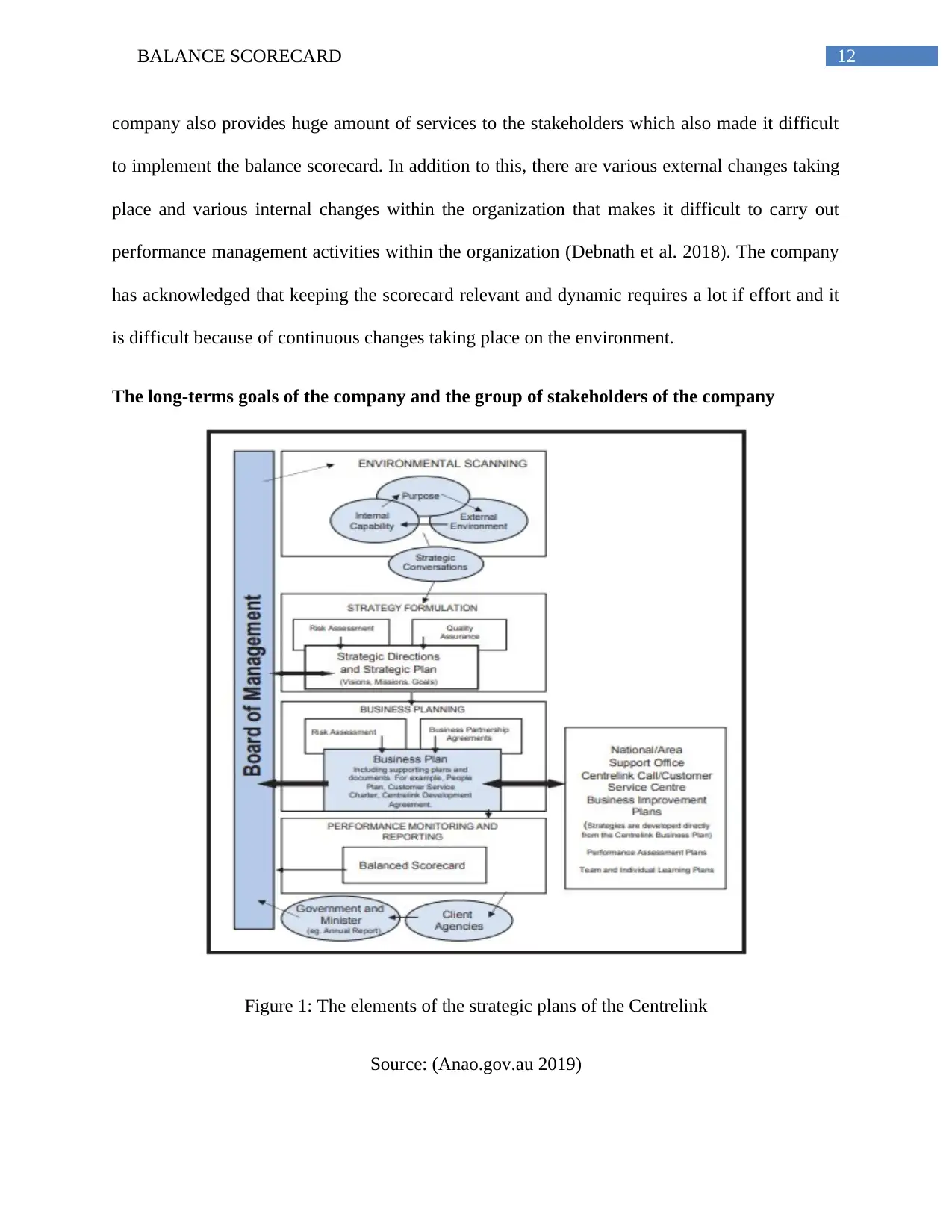
12BALANCE SCORECARD
company also provides huge amount of services to the stakeholders which also made it difficult
to implement the balance scorecard. In addition to this, there are various external changes taking
place and various internal changes within the organization that makes it difficult to carry out
performance management activities within the organization (Debnath et al. 2018). The company
has acknowledged that keeping the scorecard relevant and dynamic requires a lot if effort and it
is difficult because of continuous changes taking place on the environment.
The long-terms goals of the company and the group of stakeholders of the company
Figure 1: The elements of the strategic plans of the Centrelink
Source: (Anao.gov.au 2019)
company also provides huge amount of services to the stakeholders which also made it difficult
to implement the balance scorecard. In addition to this, there are various external changes taking
place and various internal changes within the organization that makes it difficult to carry out
performance management activities within the organization (Debnath et al. 2018). The company
has acknowledged that keeping the scorecard relevant and dynamic requires a lot if effort and it
is difficult because of continuous changes taking place on the environment.
The long-terms goals of the company and the group of stakeholders of the company
Figure 1: The elements of the strategic plans of the Centrelink
Source: (Anao.gov.au 2019)
Paraphrase This Document
Need a fresh take? Get an instant paraphrase of this document with our AI Paraphraser
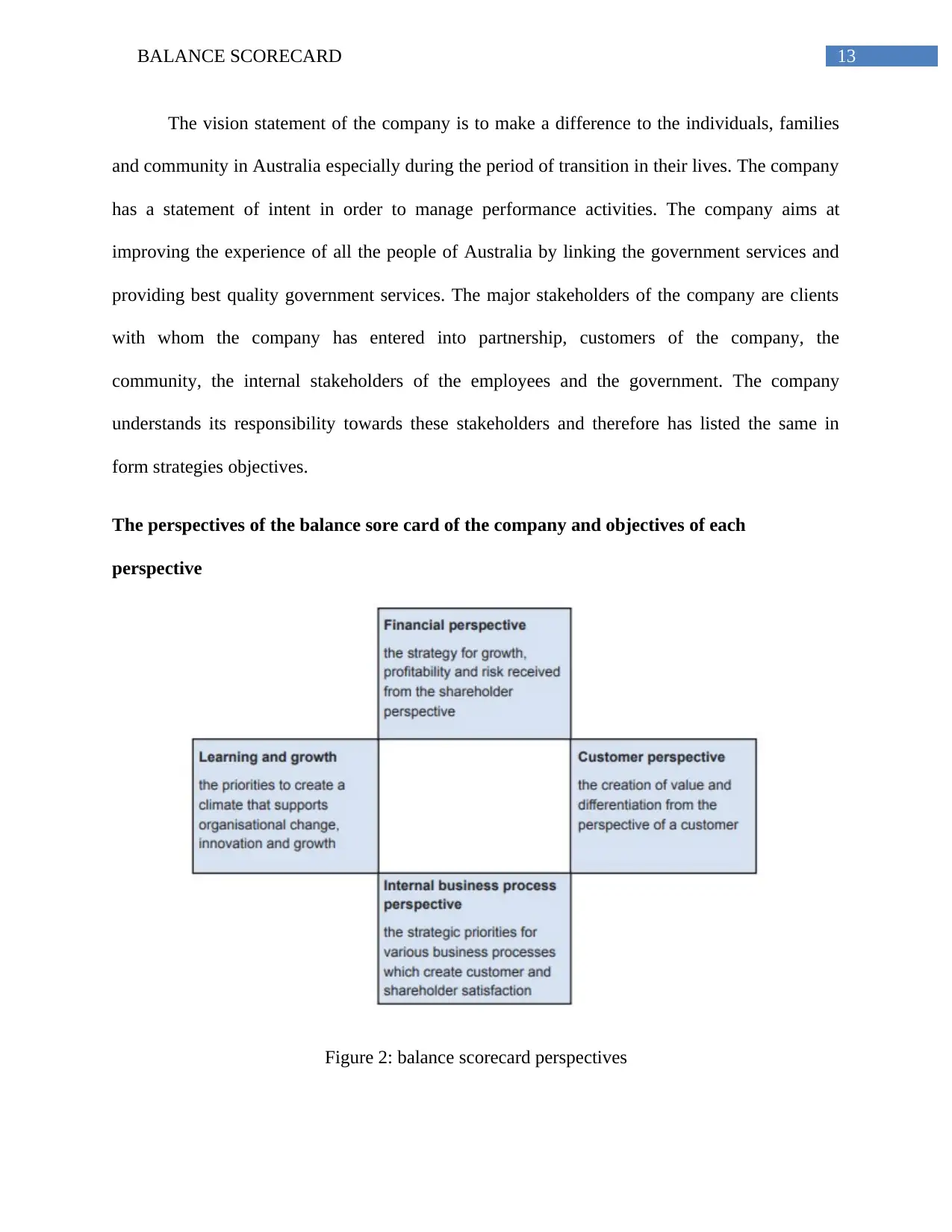
13BALANCE SCORECARD
The vision statement of the company is to make a difference to the individuals, families
and community in Australia especially during the period of transition in their lives. The company
has a statement of intent in order to manage performance activities. The company aims at
improving the experience of all the people of Australia by linking the government services and
providing best quality government services. The major stakeholders of the company are clients
with whom the company has entered into partnership, customers of the company, the
community, the internal stakeholders of the employees and the government. The company
understands its responsibility towards these stakeholders and therefore has listed the same in
form strategies objectives.
The perspectives of the balance sore card of the company and objectives of each
perspective
Figure 2: balance scorecard perspectives
The vision statement of the company is to make a difference to the individuals, families
and community in Australia especially during the period of transition in their lives. The company
has a statement of intent in order to manage performance activities. The company aims at
improving the experience of all the people of Australia by linking the government services and
providing best quality government services. The major stakeholders of the company are clients
with whom the company has entered into partnership, customers of the company, the
community, the internal stakeholders of the employees and the government. The company
understands its responsibility towards these stakeholders and therefore has listed the same in
form strategies objectives.
The perspectives of the balance sore card of the company and objectives of each
perspective
Figure 2: balance scorecard perspectives
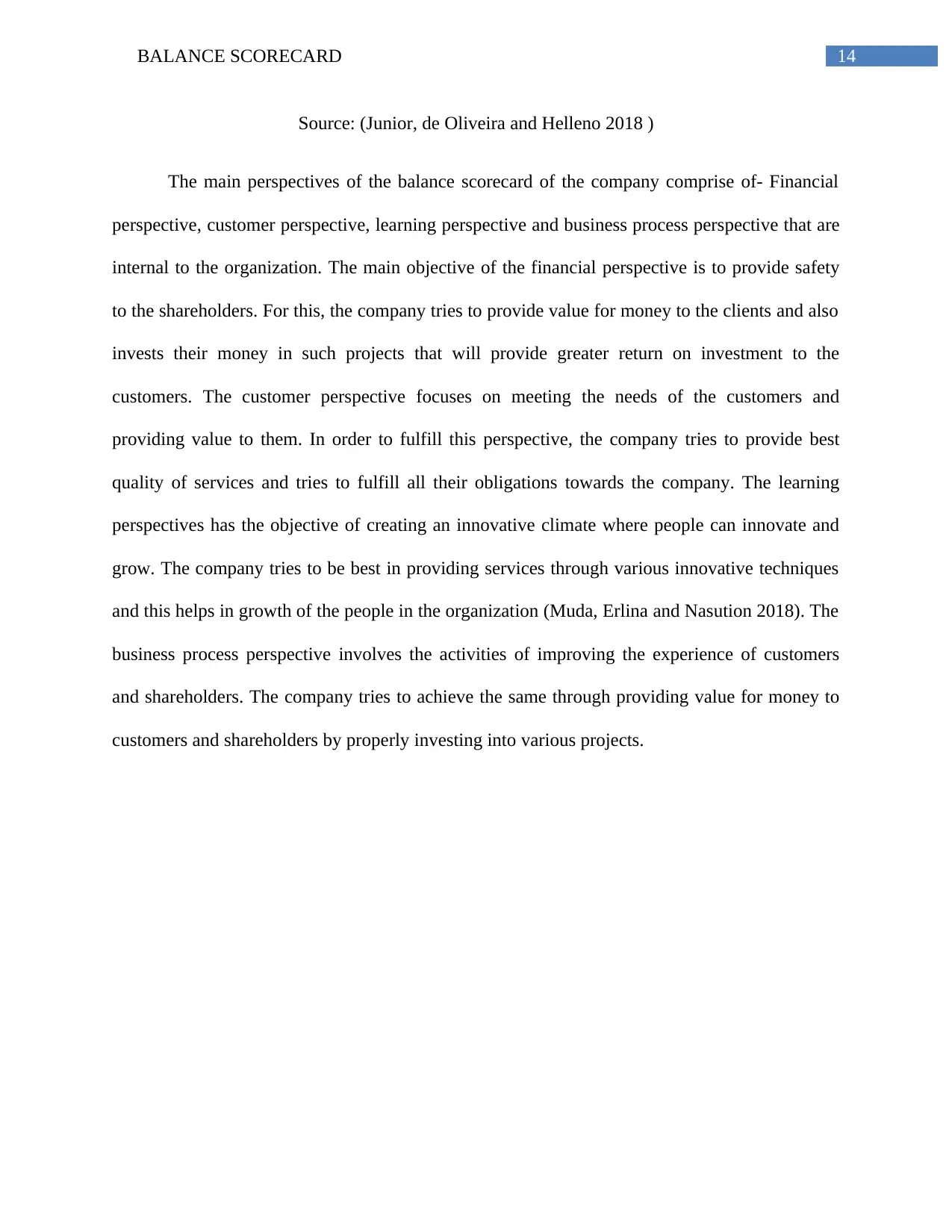
14BALANCE SCORECARD
Source: (Junior, de Oliveira and Helleno 2018 )
The main perspectives of the balance scorecard of the company comprise of- Financial
perspective, customer perspective, learning perspective and business process perspective that are
internal to the organization. The main objective of the financial perspective is to provide safety
to the shareholders. For this, the company tries to provide value for money to the clients and also
invests their money in such projects that will provide greater return on investment to the
customers. The customer perspective focuses on meeting the needs of the customers and
providing value to them. In order to fulfill this perspective, the company tries to provide best
quality of services and tries to fulfill all their obligations towards the company. The learning
perspectives has the objective of creating an innovative climate where people can innovate and
grow. The company tries to be best in providing services through various innovative techniques
and this helps in growth of the people in the organization (Muda, Erlina and Nasution 2018). The
business process perspective involves the activities of improving the experience of customers
and shareholders. The company tries to achieve the same through providing value for money to
customers and shareholders by properly investing into various projects.
Source: (Junior, de Oliveira and Helleno 2018 )
The main perspectives of the balance scorecard of the company comprise of- Financial
perspective, customer perspective, learning perspective and business process perspective that are
internal to the organization. The main objective of the financial perspective is to provide safety
to the shareholders. For this, the company tries to provide value for money to the clients and also
invests their money in such projects that will provide greater return on investment to the
customers. The customer perspective focuses on meeting the needs of the customers and
providing value to them. In order to fulfill this perspective, the company tries to provide best
quality of services and tries to fulfill all their obligations towards the company. The learning
perspectives has the objective of creating an innovative climate where people can innovate and
grow. The company tries to be best in providing services through various innovative techniques
and this helps in growth of the people in the organization (Muda, Erlina and Nasution 2018). The
business process perspective involves the activities of improving the experience of customers
and shareholders. The company tries to achieve the same through providing value for money to
customers and shareholders by properly investing into various projects.
⊘ This is a preview!⊘
Do you want full access?
Subscribe today to unlock all pages.

Trusted by 1+ million students worldwide
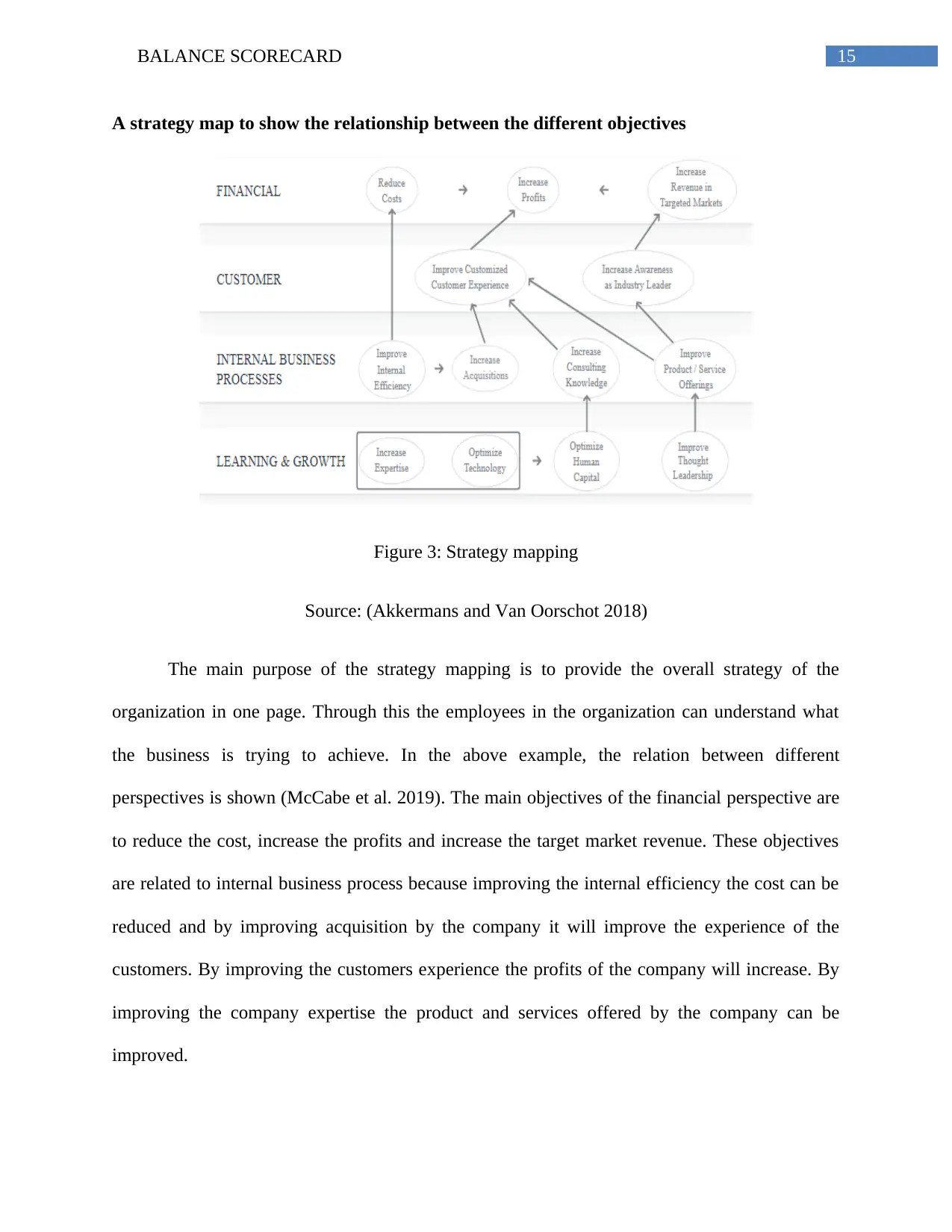
15BALANCE SCORECARD
A strategy map to show the relationship between the different objectives
Figure 3: Strategy mapping
Source: (Akkermans and Van Oorschot 2018)
The main purpose of the strategy mapping is to provide the overall strategy of the
organization in one page. Through this the employees in the organization can understand what
the business is trying to achieve. In the above example, the relation between different
perspectives is shown (McCabe et al. 2019). The main objectives of the financial perspective are
to reduce the cost, increase the profits and increase the target market revenue. These objectives
are related to internal business process because improving the internal efficiency the cost can be
reduced and by improving acquisition by the company it will improve the experience of the
customers. By improving the customers experience the profits of the company will increase. By
improving the company expertise the product and services offered by the company can be
improved.
A strategy map to show the relationship between the different objectives
Figure 3: Strategy mapping
Source: (Akkermans and Van Oorschot 2018)
The main purpose of the strategy mapping is to provide the overall strategy of the
organization in one page. Through this the employees in the organization can understand what
the business is trying to achieve. In the above example, the relation between different
perspectives is shown (McCabe et al. 2019). The main objectives of the financial perspective are
to reduce the cost, increase the profits and increase the target market revenue. These objectives
are related to internal business process because improving the internal efficiency the cost can be
reduced and by improving acquisition by the company it will improve the experience of the
customers. By improving the customers experience the profits of the company will increase. By
improving the company expertise the product and services offered by the company can be
improved.
Paraphrase This Document
Need a fresh take? Get an instant paraphrase of this document with our AI Paraphraser
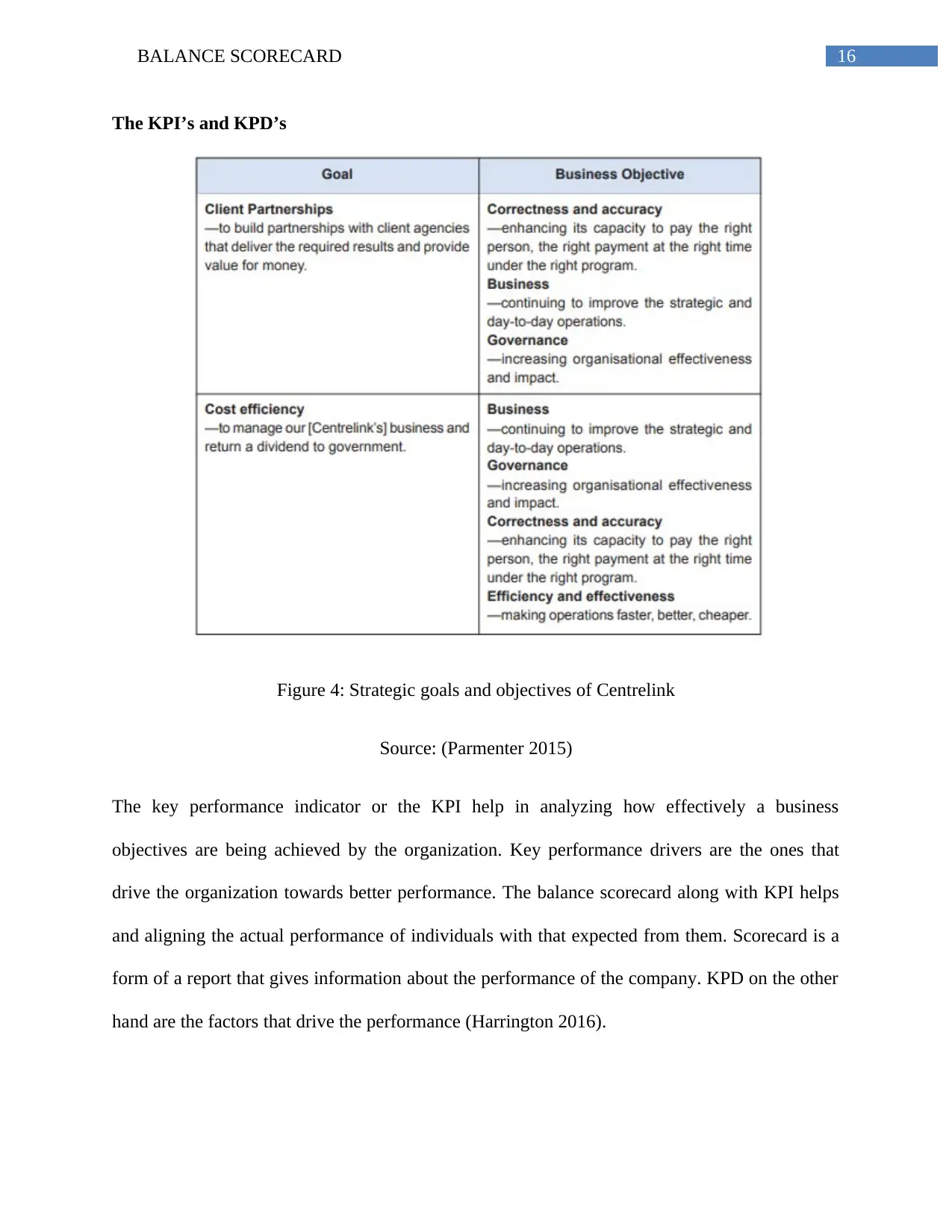
16BALANCE SCORECARD
The KPI’s and KPD’s
Figure 4: Strategic goals and objectives of Centrelink
Source: (Parmenter 2015)
The key performance indicator or the KPI help in analyzing how effectively a business
objectives are being achieved by the organization. Key performance drivers are the ones that
drive the organization towards better performance. The balance scorecard along with KPI helps
and aligning the actual performance of individuals with that expected from them. Scorecard is a
form of a report that gives information about the performance of the company. KPD on the other
hand are the factors that drive the performance (Harrington 2016).
The KPI’s and KPD’s
Figure 4: Strategic goals and objectives of Centrelink
Source: (Parmenter 2015)
The key performance indicator or the KPI help in analyzing how effectively a business
objectives are being achieved by the organization. Key performance drivers are the ones that
drive the organization towards better performance. The balance scorecard along with KPI helps
and aligning the actual performance of individuals with that expected from them. Scorecard is a
form of a report that gives information about the performance of the company. KPD on the other
hand are the factors that drive the performance (Harrington 2016).
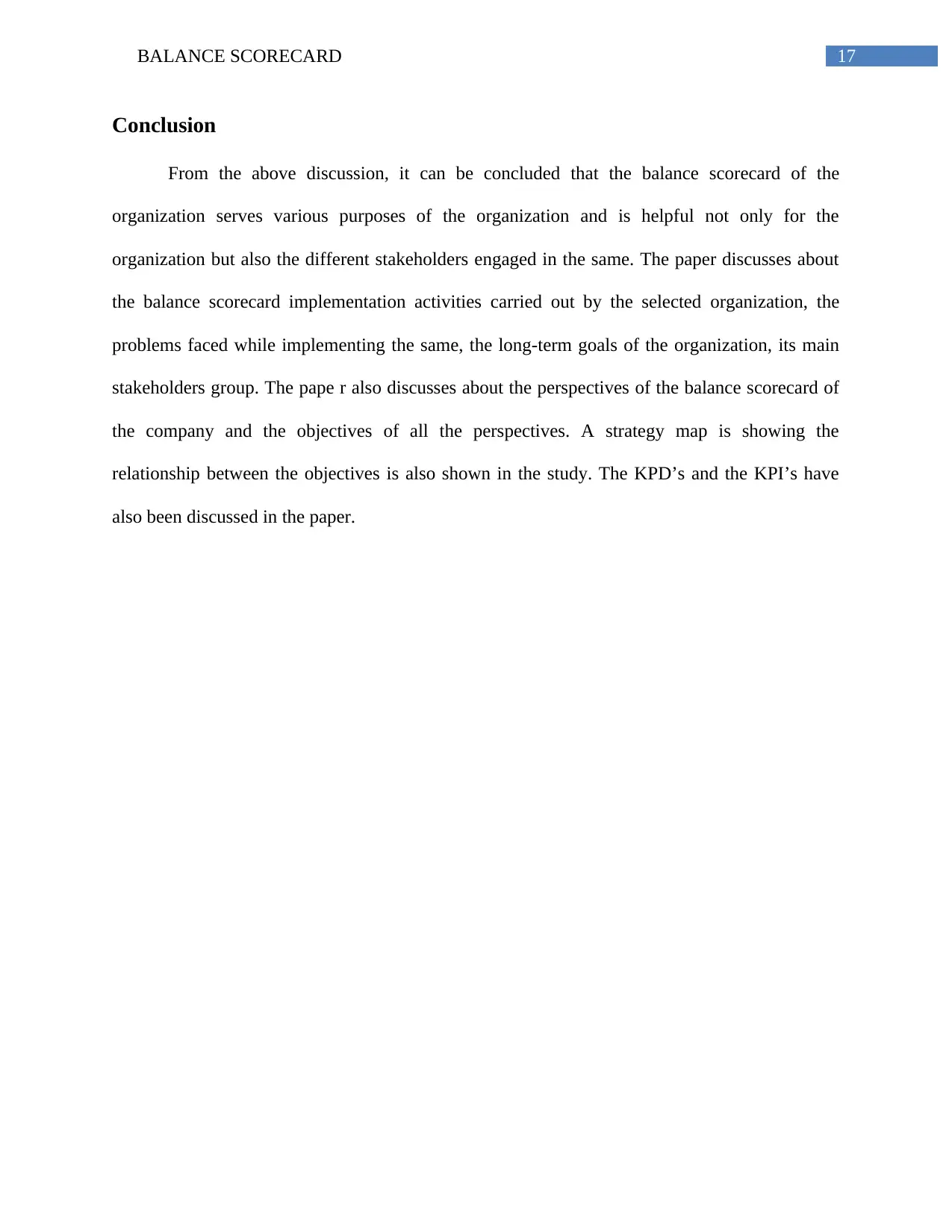
17BALANCE SCORECARD
Conclusion
From the above discussion, it can be concluded that the balance scorecard of the
organization serves various purposes of the organization and is helpful not only for the
organization but also the different stakeholders engaged in the same. The paper discusses about
the balance scorecard implementation activities carried out by the selected organization, the
problems faced while implementing the same, the long-term goals of the organization, its main
stakeholders group. The pape r also discusses about the perspectives of the balance scorecard of
the company and the objectives of all the perspectives. A strategy map is showing the
relationship between the objectives is also shown in the study. The KPD’s and the KPI’s have
also been discussed in the paper.
Conclusion
From the above discussion, it can be concluded that the balance scorecard of the
organization serves various purposes of the organization and is helpful not only for the
organization but also the different stakeholders engaged in the same. The paper discusses about
the balance scorecard implementation activities carried out by the selected organization, the
problems faced while implementing the same, the long-term goals of the organization, its main
stakeholders group. The pape r also discusses about the perspectives of the balance scorecard of
the company and the objectives of all the perspectives. A strategy map is showing the
relationship between the objectives is also shown in the study. The KPD’s and the KPI’s have
also been discussed in the paper.
⊘ This is a preview!⊘
Do you want full access?
Subscribe today to unlock all pages.

Trusted by 1+ million students worldwide
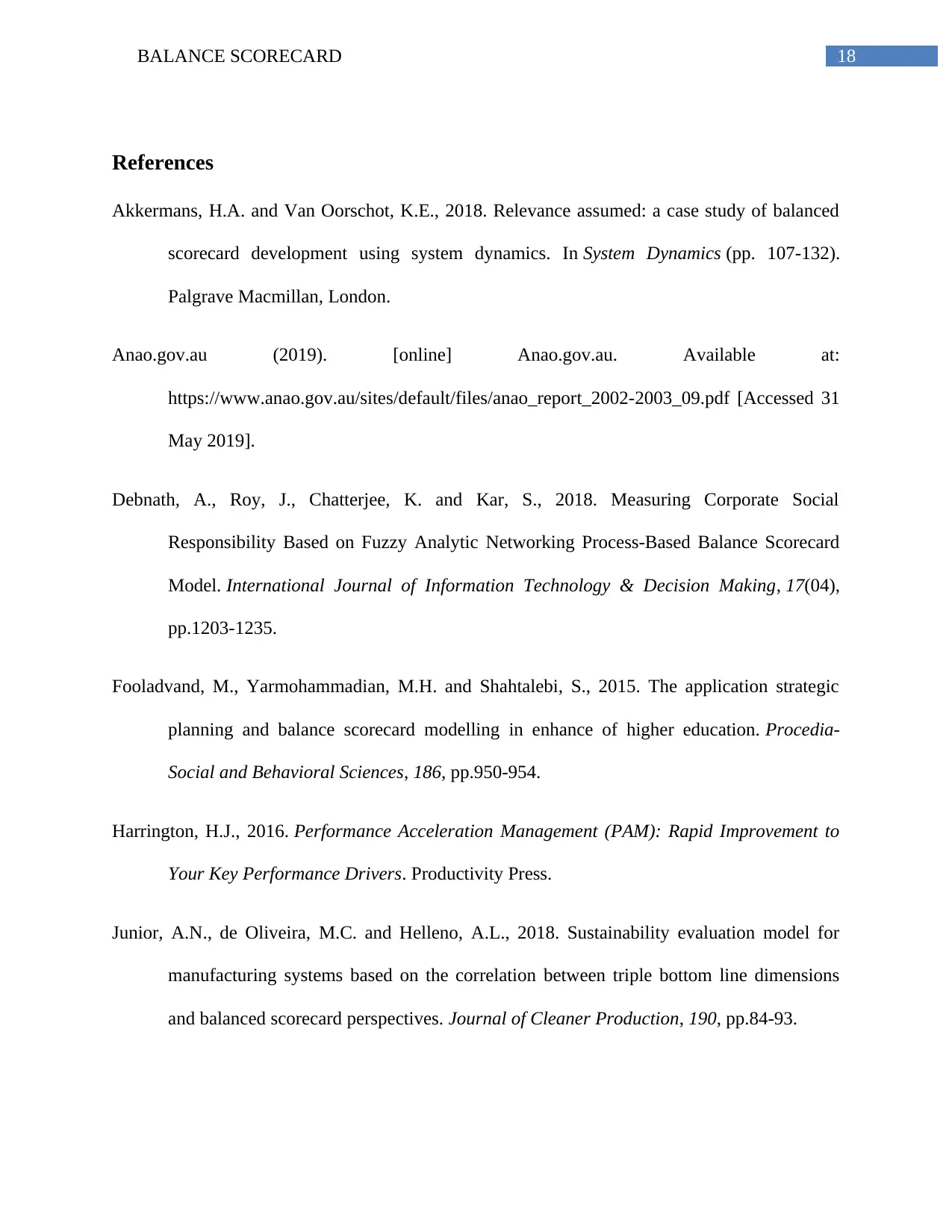
18BALANCE SCORECARD
References
Akkermans, H.A. and Van Oorschot, K.E., 2018. Relevance assumed: a case study of balanced
scorecard development using system dynamics. In System Dynamics (pp. 107-132).
Palgrave Macmillan, London.
Anao.gov.au (2019). [online] Anao.gov.au. Available at:
https://www.anao.gov.au/sites/default/files/anao_report_2002-2003_09.pdf [Accessed 31
May 2019].
Debnath, A., Roy, J., Chatterjee, K. and Kar, S., 2018. Measuring Corporate Social
Responsibility Based on Fuzzy Analytic Networking Process-Based Balance Scorecard
Model. International Journal of Information Technology & Decision Making, 17(04),
pp.1203-1235.
Fooladvand, M., Yarmohammadian, M.H. and Shahtalebi, S., 2015. The application strategic
planning and balance scorecard modelling in enhance of higher education. Procedia-
Social and Behavioral Sciences, 186, pp.950-954.
Harrington, H.J., 2016. Performance Acceleration Management (PAM): Rapid Improvement to
Your Key Performance Drivers. Productivity Press.
Junior, A.N., de Oliveira, M.C. and Helleno, A.L., 2018. Sustainability evaluation model for
manufacturing systems based on the correlation between triple bottom line dimensions
and balanced scorecard perspectives. Journal of Cleaner Production, 190, pp.84-93.
References
Akkermans, H.A. and Van Oorschot, K.E., 2018. Relevance assumed: a case study of balanced
scorecard development using system dynamics. In System Dynamics (pp. 107-132).
Palgrave Macmillan, London.
Anao.gov.au (2019). [online] Anao.gov.au. Available at:
https://www.anao.gov.au/sites/default/files/anao_report_2002-2003_09.pdf [Accessed 31
May 2019].
Debnath, A., Roy, J., Chatterjee, K. and Kar, S., 2018. Measuring Corporate Social
Responsibility Based on Fuzzy Analytic Networking Process-Based Balance Scorecard
Model. International Journal of Information Technology & Decision Making, 17(04),
pp.1203-1235.
Fooladvand, M., Yarmohammadian, M.H. and Shahtalebi, S., 2015. The application strategic
planning and balance scorecard modelling in enhance of higher education. Procedia-
Social and Behavioral Sciences, 186, pp.950-954.
Harrington, H.J., 2016. Performance Acceleration Management (PAM): Rapid Improvement to
Your Key Performance Drivers. Productivity Press.
Junior, A.N., de Oliveira, M.C. and Helleno, A.L., 2018. Sustainability evaluation model for
manufacturing systems based on the correlation between triple bottom line dimensions
and balanced scorecard perspectives. Journal of Cleaner Production, 190, pp.84-93.
Paraphrase This Document
Need a fresh take? Get an instant paraphrase of this document with our AI Paraphraser
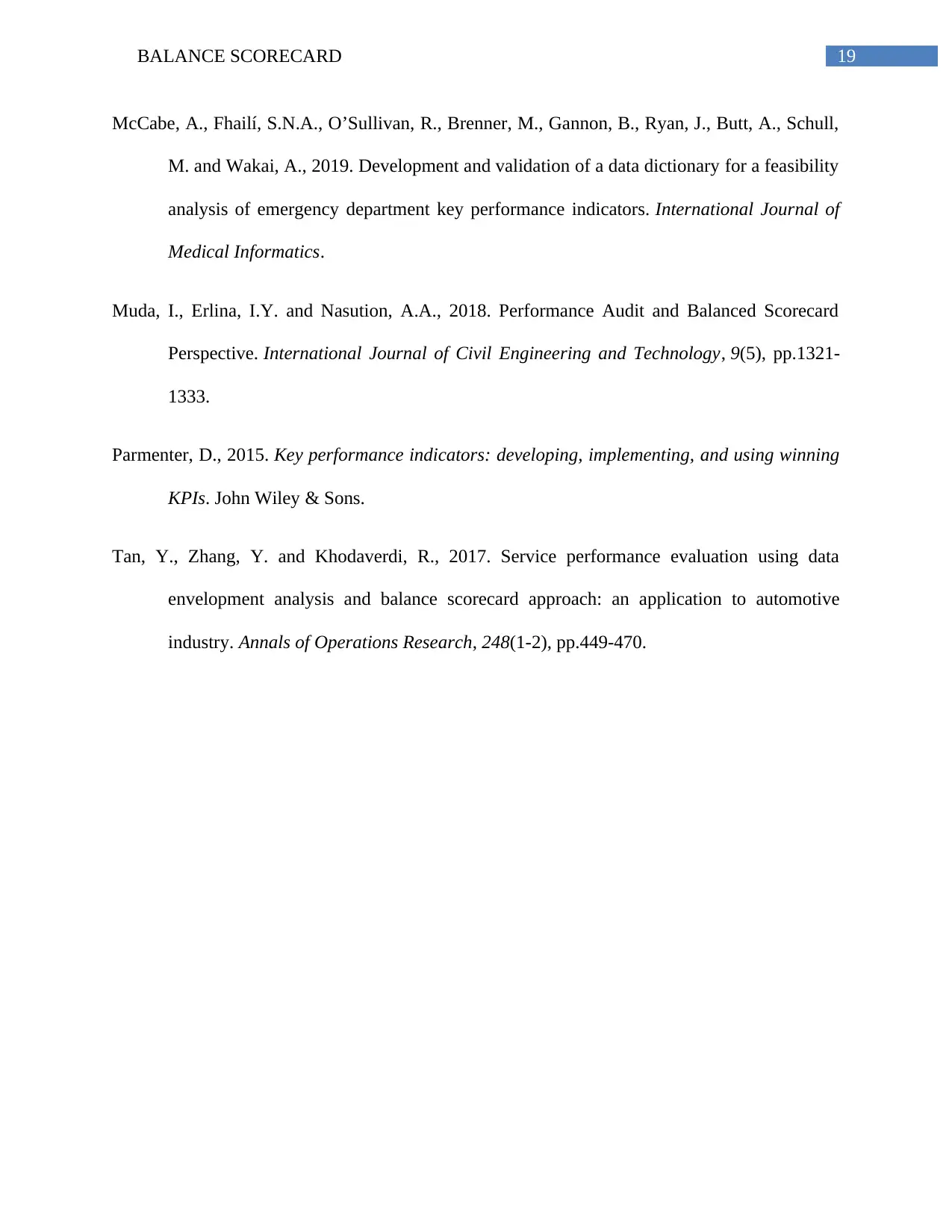
19BALANCE SCORECARD
McCabe, A., Fhailí, S.N.A., O’Sullivan, R., Brenner, M., Gannon, B., Ryan, J., Butt, A., Schull,
M. and Wakai, A., 2019. Development and validation of a data dictionary for a feasibility
analysis of emergency department key performance indicators. International Journal of
Medical Informatics.
Muda, I., Erlina, I.Y. and Nasution, A.A., 2018. Performance Audit and Balanced Scorecard
Perspective. International Journal of Civil Engineering and Technology, 9(5), pp.1321-
1333.
Parmenter, D., 2015. Key performance indicators: developing, implementing, and using winning
KPIs. John Wiley & Sons.
Tan, Y., Zhang, Y. and Khodaverdi, R., 2017. Service performance evaluation using data
envelopment analysis and balance scorecard approach: an application to automotive
industry. Annals of Operations Research, 248(1-2), pp.449-470.
McCabe, A., Fhailí, S.N.A., O’Sullivan, R., Brenner, M., Gannon, B., Ryan, J., Butt, A., Schull,
M. and Wakai, A., 2019. Development and validation of a data dictionary for a feasibility
analysis of emergency department key performance indicators. International Journal of
Medical Informatics.
Muda, I., Erlina, I.Y. and Nasution, A.A., 2018. Performance Audit and Balanced Scorecard
Perspective. International Journal of Civil Engineering and Technology, 9(5), pp.1321-
1333.
Parmenter, D., 2015. Key performance indicators: developing, implementing, and using winning
KPIs. John Wiley & Sons.
Tan, Y., Zhang, Y. and Khodaverdi, R., 2017. Service performance evaluation using data
envelopment analysis and balance scorecard approach: an application to automotive
industry. Annals of Operations Research, 248(1-2), pp.449-470.
1 out of 11
Related Documents
Your All-in-One AI-Powered Toolkit for Academic Success.
+13062052269
info@desklib.com
Available 24*7 on WhatsApp / Email
![[object Object]](/_next/static/media/star-bottom.7253800d.svg)
Unlock your academic potential
Copyright © 2020–2025 A2Z Services. All Rights Reserved. Developed and managed by ZUCOL.




